CHCADV002: Advocacy and Representation Services - Assessment Book
VerifiedAdded on 2020/07/22
|34
|8300
|917
Homework Assignment
AI Summary
This document is an assessment book for the CHCADV002 unit, focusing on providing advocacy and representation services. The assessment covers the definition and role of advocacy within case management, exploring different types such as individual, systems, self, and citizen/parent advocacy. It requires the student to define the role of a representative and identify common groups and issues requiring advocacy, including Aboriginal and Torres Strait Islander people, older individuals, individuals with alcohol and other drug concerns, individuals with chronic disease, culturally and linguistically diverse individuals, individuals with a disability, individuals with mental health issues, individuals who self-injure, children and youth, women's issues, and men's health. The assessment includes multiple-choice questions and requires the student to complete tables and provide concise descriptions, demonstrating their understanding of advocacy principles and the specific challenges faced by various groups. The assessment is designed for students at the Australian Institute of Professional Counsellors (AIPC).
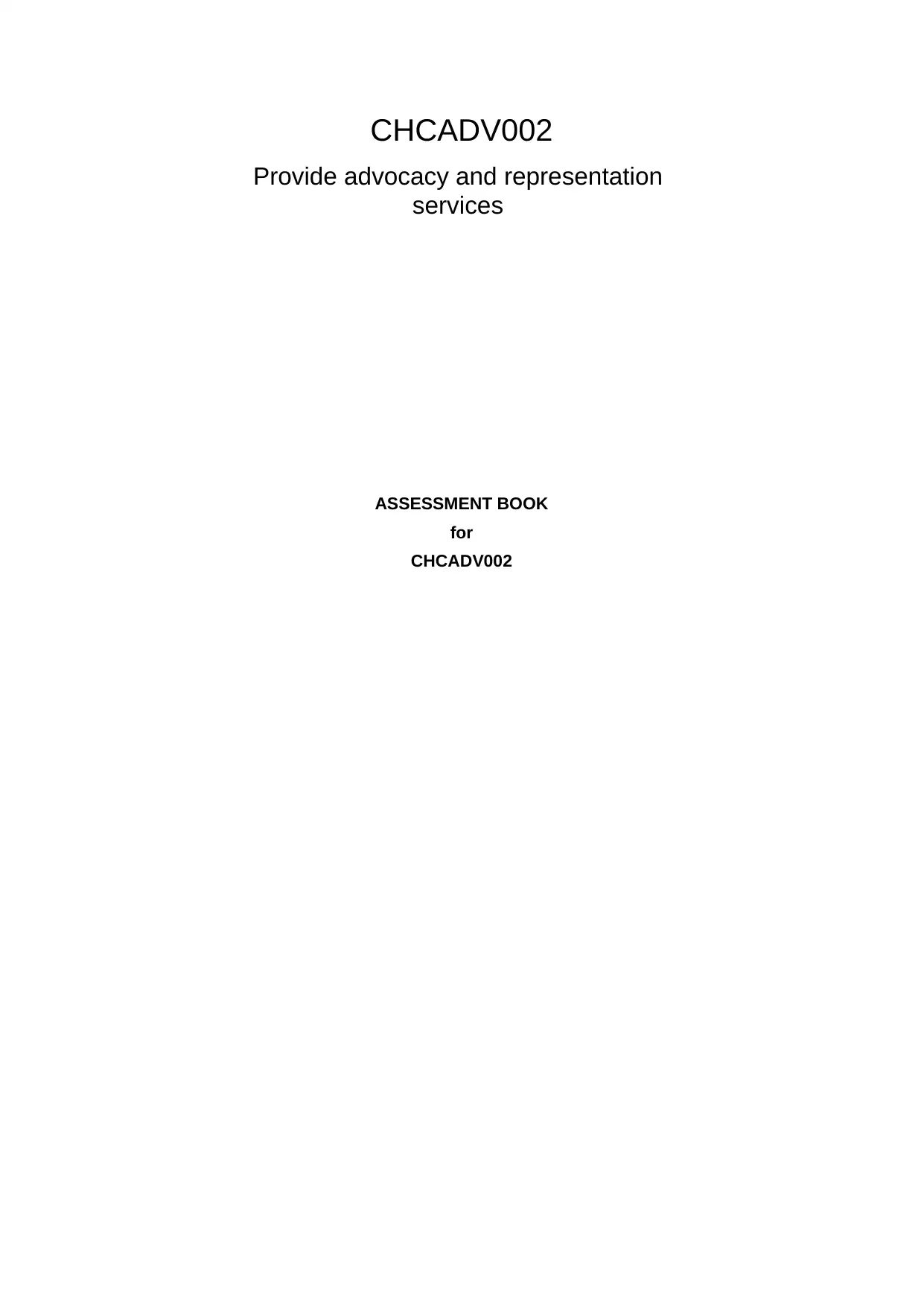
CHCADV002
Provide advocacy and representation
services
ASSESSMENT BOOK
for
CHCADV002
Provide advocacy and representation
services
ASSESSMENT BOOK
for
CHCADV002
Paraphrase This Document
Need a fresh take? Get an instant paraphrase of this document with our AI Paraphraser

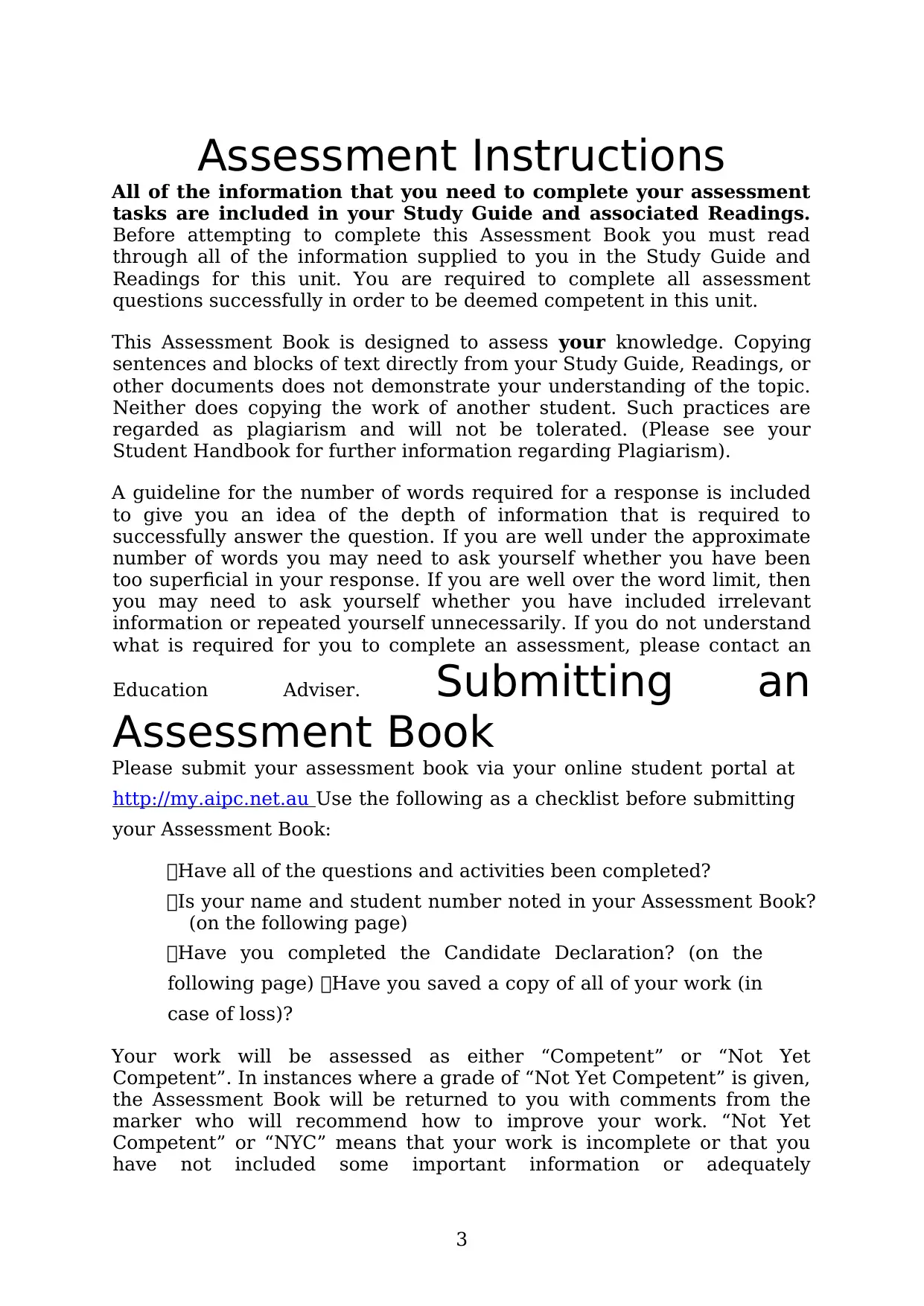
Assessment Instructions
All of the information that you need to complete your assessment
tasks are included in your Study Guide and associated Readings.
Before attempting to complete this Assessment Book you must read
through all of the information supplied to you in the Study Guide and
Readings for this unit. You are required to complete all assessment
questions successfully in order to be deemed competent in this unit.
This Assessment Book is designed to assess your knowledge. Copying
sentences and blocks of text directly from your Study Guide, Readings, or
other documents does not demonstrate your understanding of the topic.
Neither does copying the work of another student. Such practices are
regarded as plagiarism and will not be tolerated. (Please see your
Student Handbook for further information regarding Plagiarism).
A guideline for the number of words required for a response is included
to give you an idea of the depth of information that is required to
successfully answer the question. If you are well under the approximate
number of words you may need to ask yourself whether you have been
too superficial in your response. If you are well over the word limit, then
you may need to ask yourself whether you have included irrelevant
information or repeated yourself unnecessarily. If you do not understand
what is required for you to complete an assessment, please contact an
Education Adviser. Submitting an
Assessment Book
Please submit your assessment book via your online student portal at
http://my.aipc.net.au Use the following as a checklist before submitting
your Assessment Book:
Have all of the questions and activities been completed?
Is your name and student number noted in your Assessment Book?
(on the following page)
Have you completed the Candidate Declaration? (on the
following page) Have you saved a copy of all of your work (in
case of loss)?
Your work will be assessed as either “Competent” or “Not Yet
Competent”. In instances where a grade of “Not Yet Competent” is given,
the Assessment Book will be returned to you with comments from the
marker who will recommend how to improve your work. “Not Yet
Competent” or “NYC” means that your work is incomplete or that you
have not included some important information or adequately
3
All of the information that you need to complete your assessment
tasks are included in your Study Guide and associated Readings.
Before attempting to complete this Assessment Book you must read
through all of the information supplied to you in the Study Guide and
Readings for this unit. You are required to complete all assessment
questions successfully in order to be deemed competent in this unit.
This Assessment Book is designed to assess your knowledge. Copying
sentences and blocks of text directly from your Study Guide, Readings, or
other documents does not demonstrate your understanding of the topic.
Neither does copying the work of another student. Such practices are
regarded as plagiarism and will not be tolerated. (Please see your
Student Handbook for further information regarding Plagiarism).
A guideline for the number of words required for a response is included
to give you an idea of the depth of information that is required to
successfully answer the question. If you are well under the approximate
number of words you may need to ask yourself whether you have been
too superficial in your response. If you are well over the word limit, then
you may need to ask yourself whether you have included irrelevant
information or repeated yourself unnecessarily. If you do not understand
what is required for you to complete an assessment, please contact an
Education Adviser. Submitting an
Assessment Book
Please submit your assessment book via your online student portal at
http://my.aipc.net.au Use the following as a checklist before submitting
your Assessment Book:
Have all of the questions and activities been completed?
Is your name and student number noted in your Assessment Book?
(on the following page)
Have you completed the Candidate Declaration? (on the
following page) Have you saved a copy of all of your work (in
case of loss)?
Your work will be assessed as either “Competent” or “Not Yet
Competent”. In instances where a grade of “Not Yet Competent” is given,
the Assessment Book will be returned to you with comments from the
marker who will recommend how to improve your work. “Not Yet
Competent” or “NYC” means that your work is incomplete or that you
have not included some important information or adequately
3
⊘ This is a preview!⊘
Do you want full access?
Subscribe today to unlock all pages.

Trusted by 1+ million students worldwide
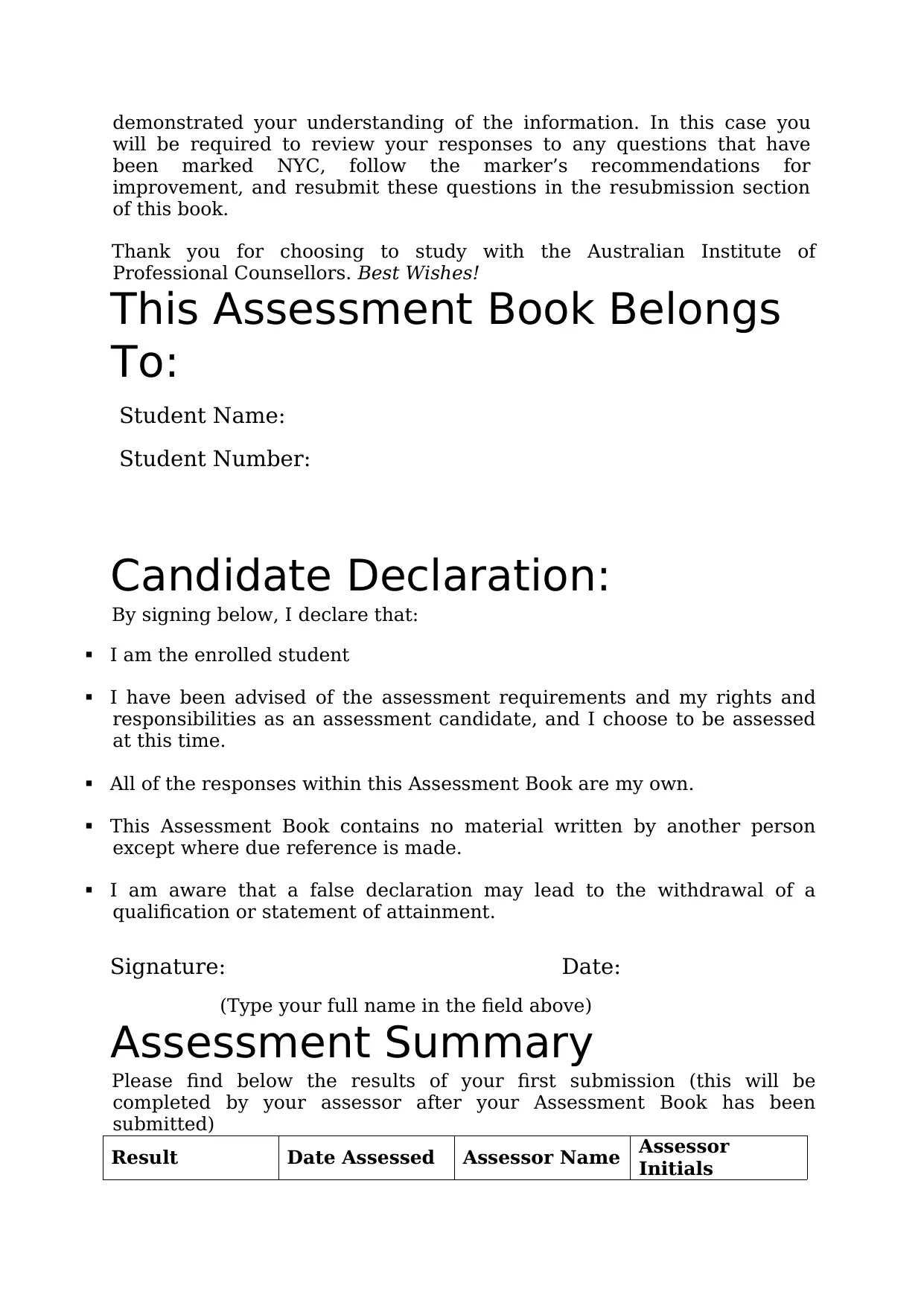
demonstrated your understanding of the information. In this case you
will be required to review your responses to any questions that have
been marked NYC, follow the marker’s recommendations for
improvement, and resubmit these questions in the resubmission section
of this book.
Thank you for choosing to study with the Australian Institute of
Professional Counsellors. Best Wishes!
This Assessment Book Belongs
To:
Student Name:
Student Number:
Candidate Declaration:
By signing below, I declare that:
I am the enrolled student
I have been advised of the assessment requirements and my rights and
responsibilities as an assessment candidate, and I choose to be assessed
at this time.
All of the responses within this Assessment Book are my own.
This Assessment Book contains no material written by another person
except where due reference is made.
I am aware that a false declaration may lead to the withdrawal of a
qualification or statement of attainment.
Signature: Date:
(Type your full name in the field above)
Assessment Summary
Please find below the results of your first submission (this will be
completed by your assessor after your Assessment Book has been
submitted)
Result Date Assessed Assessor Name Assessor
Initials
will be required to review your responses to any questions that have
been marked NYC, follow the marker’s recommendations for
improvement, and resubmit these questions in the resubmission section
of this book.
Thank you for choosing to study with the Australian Institute of
Professional Counsellors. Best Wishes!
This Assessment Book Belongs
To:
Student Name:
Student Number:
Candidate Declaration:
By signing below, I declare that:
I am the enrolled student
I have been advised of the assessment requirements and my rights and
responsibilities as an assessment candidate, and I choose to be assessed
at this time.
All of the responses within this Assessment Book are my own.
This Assessment Book contains no material written by another person
except where due reference is made.
I am aware that a false declaration may lead to the withdrawal of a
qualification or statement of attainment.
Signature: Date:
(Type your full name in the field above)
Assessment Summary
Please find below the results of your first submission (this will be
completed by your assessor after your Assessment Book has been
submitted)
Result Date Assessed Assessor Name Assessor
Initials
Paraphrase This Document
Need a fresh take? Get an instant paraphrase of this document with our AI Paraphraser
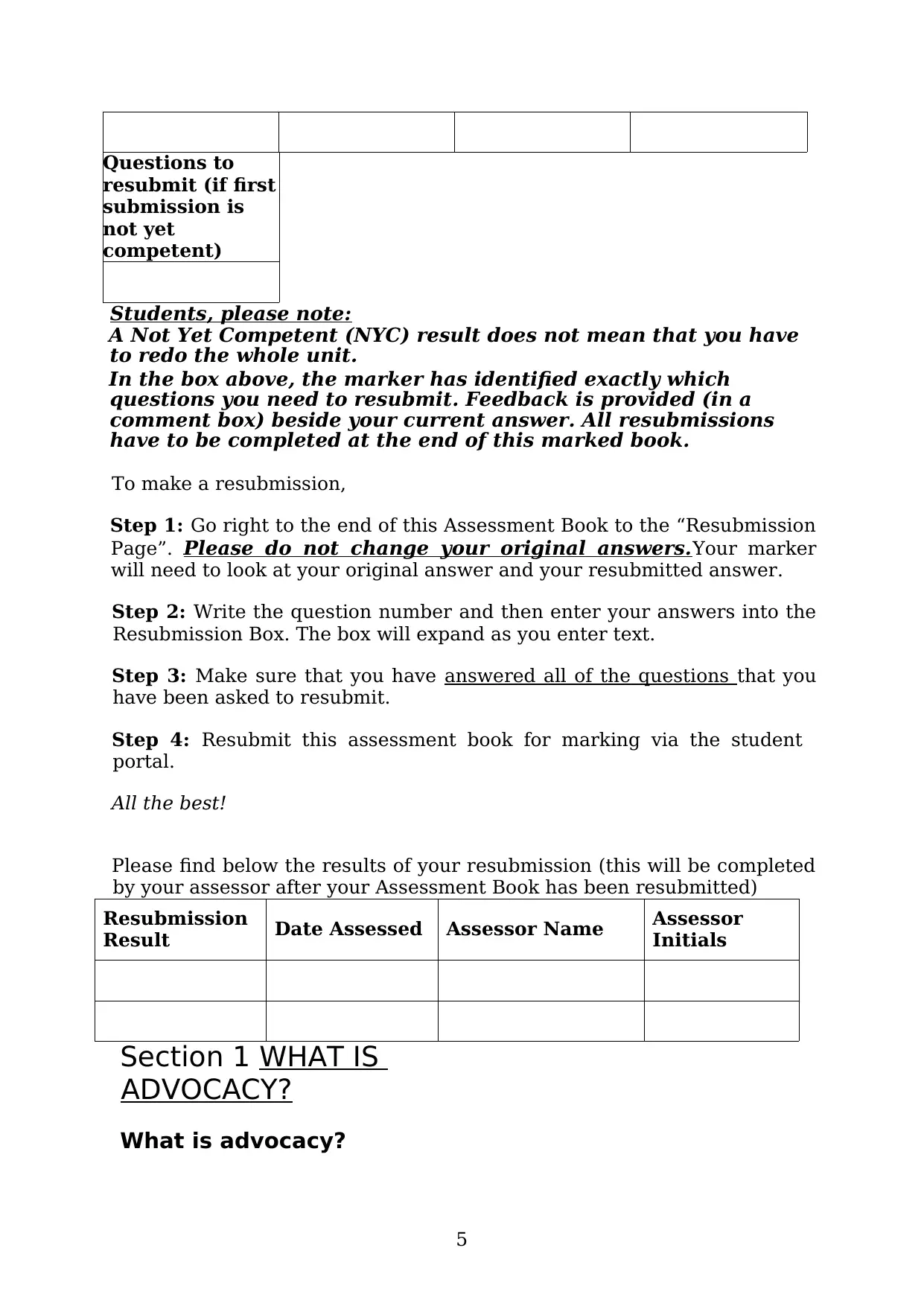
Questions to
resubmit (if first
submission is
not yet
competent)
Students, please note:
A Not Yet Competent (NYC) result does not mean that you have
to redo the whole unit.
In the box above, the marker has identified exactly which
questions you need to resubmit. Feedback is provided (in a
comment box) beside your current answer. All resubmissions
have to be completed at the end of this marked book.
To make a resubmission,
Step 1: Go right to the end of this Assessment Book to the “Resubmission
Page”. Please do not change your original answers.Your marker
will need to look at your original answer and your resubmitted answer.
Step 2: Write the question number and then enter your answers into the
Resubmission Box. The box will expand as you enter text.
Step 3: Make sure that you have answered all of the questions that you
have been asked to resubmit.
Step 4: Resubmit this assessment book for marking via the student
portal.
All the best!
Please find below the results of your resubmission (this will be completed
by your assessor after your Assessment Book has been resubmitted)
Resubmission
Result Date Assessed Assessor Name Assessor
Initials
Section 1 WHAT IS
ADVOCACY?
What is advocacy?
5
resubmit (if first
submission is
not yet
competent)
Students, please note:
A Not Yet Competent (NYC) result does not mean that you have
to redo the whole unit.
In the box above, the marker has identified exactly which
questions you need to resubmit. Feedback is provided (in a
comment box) beside your current answer. All resubmissions
have to be completed at the end of this marked book.
To make a resubmission,
Step 1: Go right to the end of this Assessment Book to the “Resubmission
Page”. Please do not change your original answers.Your marker
will need to look at your original answer and your resubmitted answer.
Step 2: Write the question number and then enter your answers into the
Resubmission Box. The box will expand as you enter text.
Step 3: Make sure that you have answered all of the questions that you
have been asked to resubmit.
Step 4: Resubmit this assessment book for marking via the student
portal.
All the best!
Please find below the results of your resubmission (this will be completed
by your assessor after your Assessment Book has been resubmitted)
Resubmission
Result Date Assessed Assessor Name Assessor
Initials
Section 1 WHAT IS
ADVOCACY?
What is advocacy?
5
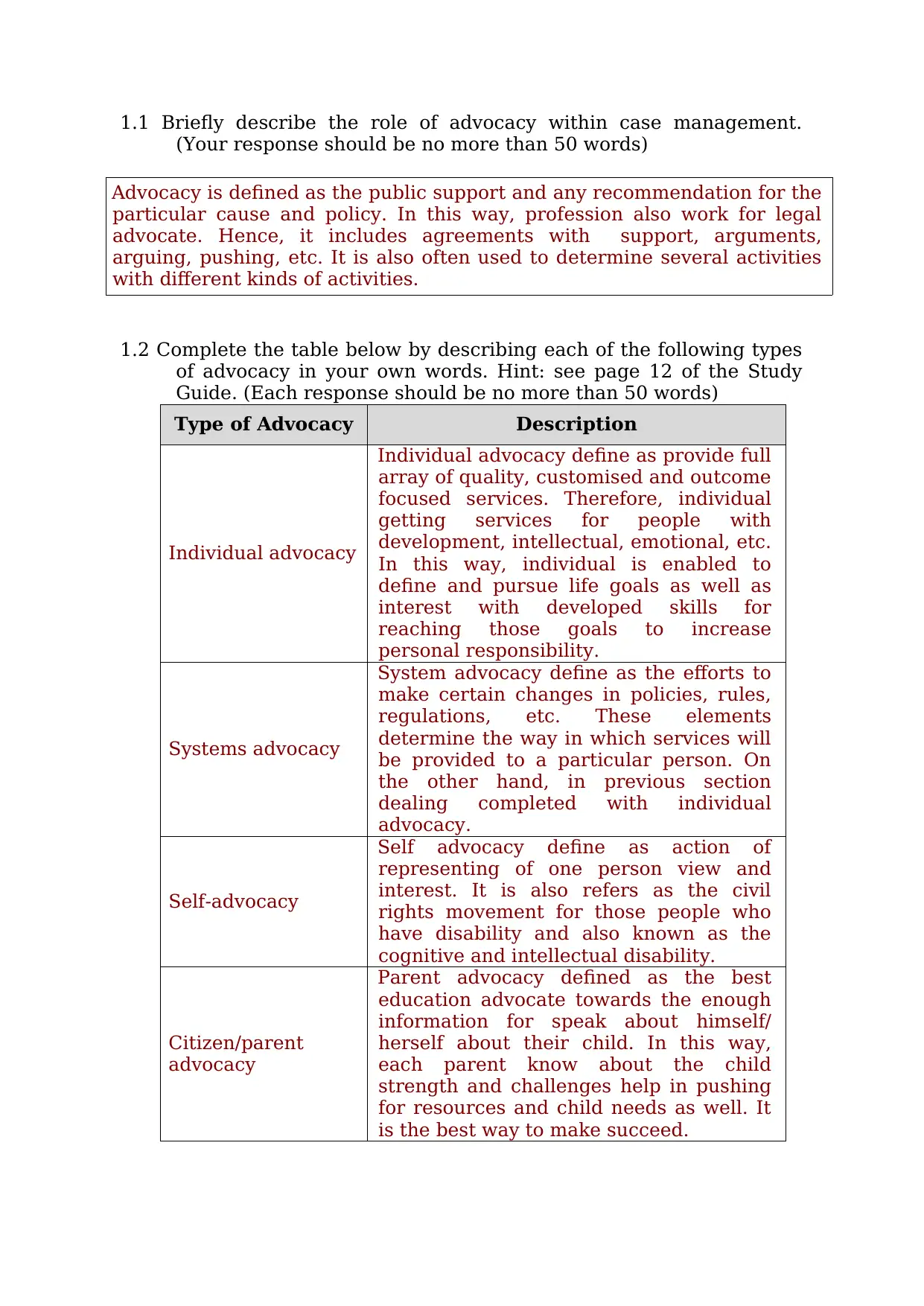
1.1 Briefly describe the role of advocacy within case management.
(Your response should be no more than 50 words)
Advocacy is defined as the public support and any recommendation for the
particular cause and policy. In this way, profession also work for legal
advocate. Hence, it includes agreements with support, arguments,
arguing, pushing, etc. It is also often used to determine several activities
with different kinds of activities.
1.2 Complete the table below by describing each of the following types
of advocacy in your own words. Hint: see page 12 of the Study
Guide. (Each response should be no more than 50 words)
Type of Advocacy Description
Individual advocacy
Individual advocacy define as provide full
array of quality, customised and outcome
focused services. Therefore, individual
getting services for people with
development, intellectual, emotional, etc.
In this way, individual is enabled to
define and pursue life goals as well as
interest with developed skills for
reaching those goals to increase
personal responsibility.
Systems advocacy
System advocacy define as the efforts to
make certain changes in policies, rules,
regulations, etc. These elements
determine the way in which services will
be provided to a particular person. On
the other hand, in previous section
dealing completed with individual
advocacy.
Self-advocacy
Self advocacy define as action of
representing of one person view and
interest. It is also refers as the civil
rights movement for those people who
have disability and also known as the
cognitive and intellectual disability.
Citizen/parent
advocacy
Parent advocacy defined as the best
education advocate towards the enough
information for speak about himself/
herself about their child. In this way,
each parent know about the child
strength and challenges help in pushing
for resources and child needs as well. It
is the best way to make succeed.
(Your response should be no more than 50 words)
Advocacy is defined as the public support and any recommendation for the
particular cause and policy. In this way, profession also work for legal
advocate. Hence, it includes agreements with support, arguments,
arguing, pushing, etc. It is also often used to determine several activities
with different kinds of activities.
1.2 Complete the table below by describing each of the following types
of advocacy in your own words. Hint: see page 12 of the Study
Guide. (Each response should be no more than 50 words)
Type of Advocacy Description
Individual advocacy
Individual advocacy define as provide full
array of quality, customised and outcome
focused services. Therefore, individual
getting services for people with
development, intellectual, emotional, etc.
In this way, individual is enabled to
define and pursue life goals as well as
interest with developed skills for
reaching those goals to increase
personal responsibility.
Systems advocacy
System advocacy define as the efforts to
make certain changes in policies, rules,
regulations, etc. These elements
determine the way in which services will
be provided to a particular person. On
the other hand, in previous section
dealing completed with individual
advocacy.
Self-advocacy
Self advocacy define as action of
representing of one person view and
interest. It is also refers as the civil
rights movement for those people who
have disability and also known as the
cognitive and intellectual disability.
Citizen/parent
advocacy
Parent advocacy defined as the best
education advocate towards the enough
information for speak about himself/
herself about their child. In this way,
each parent know about the child
strength and challenges help in pushing
for resources and child needs as well. It
is the best way to make succeed.
⊘ This is a preview!⊘
Do you want full access?
Subscribe today to unlock all pages.

Trusted by 1+ million students worldwide
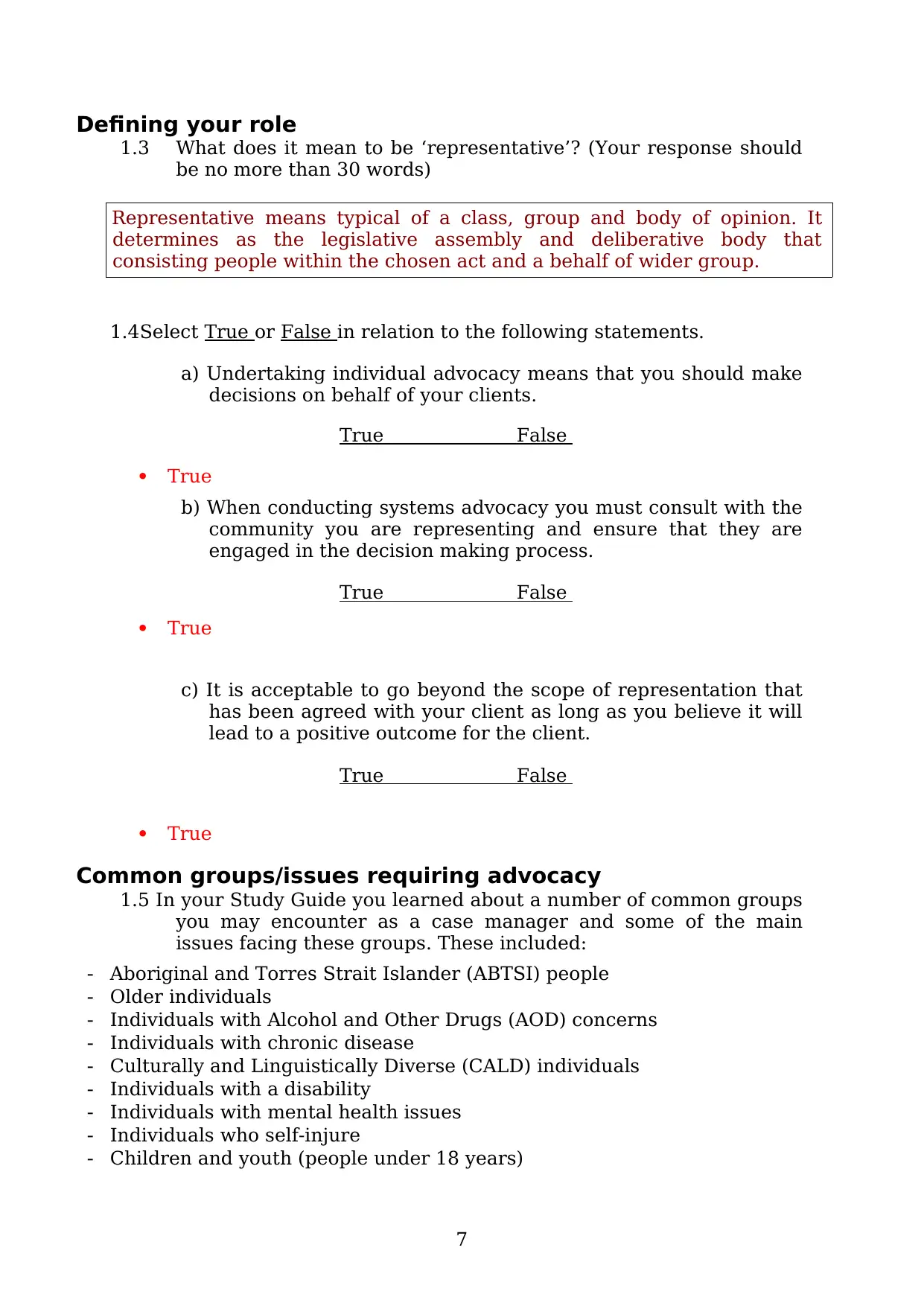
Defining your role
1.3 What does it mean to be ‘representative’? (Your response should
be no more than 30 words)
Representative means typical of a class, group and body of opinion. It
determines as the legislative assembly and deliberative body that
consisting people within the chosen act and a behalf of wider group.
1.4Select True or False in relation to the following statements.
a) Undertaking individual advocacy means that you should make
decisions on behalf of your clients.
True False
True
b) When conducting systems advocacy you must consult with the
community you are representing and ensure that they are
engaged in the decision making process.
True False
True
c) It is acceptable to go beyond the scope of representation that
has been agreed with your client as long as you believe it will
lead to a positive outcome for the client.
True False
True
Common groups/issues requiring advocacy
1.5 In your Study Guide you learned about a number of common groups
you may encounter as a case manager and some of the main
issues facing these groups. These included:
- Aboriginal and Torres Strait Islander (ABTSI) people
- Older individuals
- Individuals with Alcohol and Other Drugs (AOD) concerns
- Individuals with chronic disease
- Culturally and Linguistically Diverse (CALD) individuals
- Individuals with a disability
- Individuals with mental health issues
- Individuals who self-injure
- Children and youth (people under 18 years)
7
1.3 What does it mean to be ‘representative’? (Your response should
be no more than 30 words)
Representative means typical of a class, group and body of opinion. It
determines as the legislative assembly and deliberative body that
consisting people within the chosen act and a behalf of wider group.
1.4Select True or False in relation to the following statements.
a) Undertaking individual advocacy means that you should make
decisions on behalf of your clients.
True False
True
b) When conducting systems advocacy you must consult with the
community you are representing and ensure that they are
engaged in the decision making process.
True False
True
c) It is acceptable to go beyond the scope of representation that
has been agreed with your client as long as you believe it will
lead to a positive outcome for the client.
True False
True
Common groups/issues requiring advocacy
1.5 In your Study Guide you learned about a number of common groups
you may encounter as a case manager and some of the main
issues facing these groups. These included:
- Aboriginal and Torres Strait Islander (ABTSI) people
- Older individuals
- Individuals with Alcohol and Other Drugs (AOD) concerns
- Individuals with chronic disease
- Culturally and Linguistically Diverse (CALD) individuals
- Individuals with a disability
- Individuals with mental health issues
- Individuals who self-injure
- Children and youth (people under 18 years)
7
Paraphrase This Document
Need a fresh take? Get an instant paraphrase of this document with our AI Paraphraser
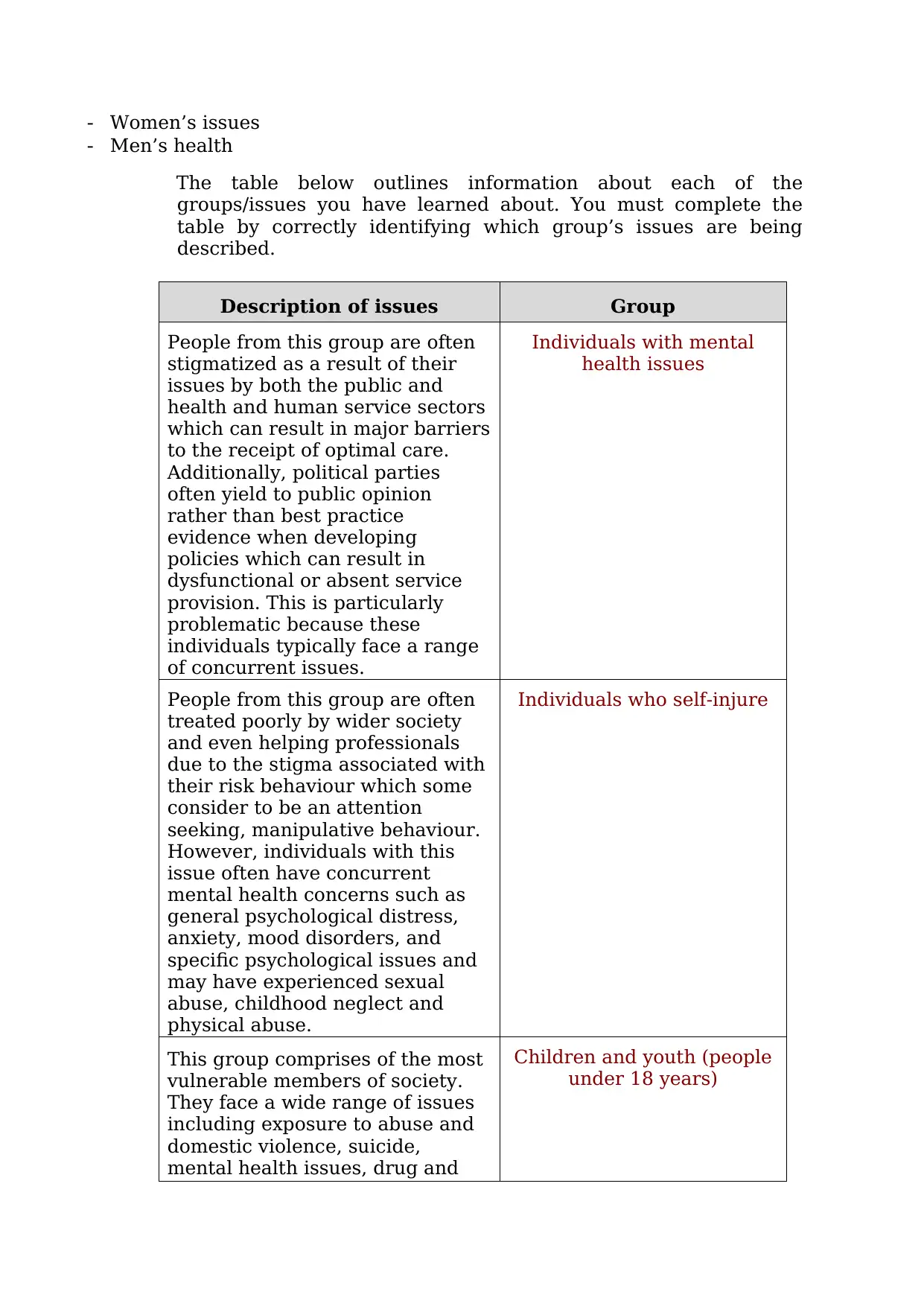
- Women’s issues
- Men’s health
The table below outlines information about each of the
groups/issues you have learned about. You must complete the
table by correctly identifying which group’s issues are being
described.
Description of issues Group
People from this group are often
stigmatized as a result of their
issues by both the public and
health and human service sectors
which can result in major barriers
to the receipt of optimal care.
Additionally, political parties
often yield to public opinion
rather than best practice
evidence when developing
policies which can result in
dysfunctional or absent service
provision. This is particularly
problematic because these
individuals typically face a range
of concurrent issues.
Individuals with mental
health issues
People from this group are often
treated poorly by wider society
and even helping professionals
due to the stigma associated with
their risk behaviour which some
consider to be an attention
seeking, manipulative behaviour.
However, individuals with this
issue often have concurrent
mental health concerns such as
general psychological distress,
anxiety, mood disorders, and
specific psychological issues and
may have experienced sexual
abuse, childhood neglect and
physical abuse.
Individuals who self-injure
This group comprises of the most
vulnerable members of society.
They face a wide range of issues
including exposure to abuse and
domestic violence, suicide,
mental health issues, drug and
Children and youth (people
under 18 years)
- Men’s health
The table below outlines information about each of the
groups/issues you have learned about. You must complete the
table by correctly identifying which group’s issues are being
described.
Description of issues Group
People from this group are often
stigmatized as a result of their
issues by both the public and
health and human service sectors
which can result in major barriers
to the receipt of optimal care.
Additionally, political parties
often yield to public opinion
rather than best practice
evidence when developing
policies which can result in
dysfunctional or absent service
provision. This is particularly
problematic because these
individuals typically face a range
of concurrent issues.
Individuals with mental
health issues
People from this group are often
treated poorly by wider society
and even helping professionals
due to the stigma associated with
their risk behaviour which some
consider to be an attention
seeking, manipulative behaviour.
However, individuals with this
issue often have concurrent
mental health concerns such as
general psychological distress,
anxiety, mood disorders, and
specific psychological issues and
may have experienced sexual
abuse, childhood neglect and
physical abuse.
Individuals who self-injure
This group comprises of the most
vulnerable members of society.
They face a wide range of issues
including exposure to abuse and
domestic violence, suicide,
mental health issues, drug and
Children and youth (people
under 18 years)
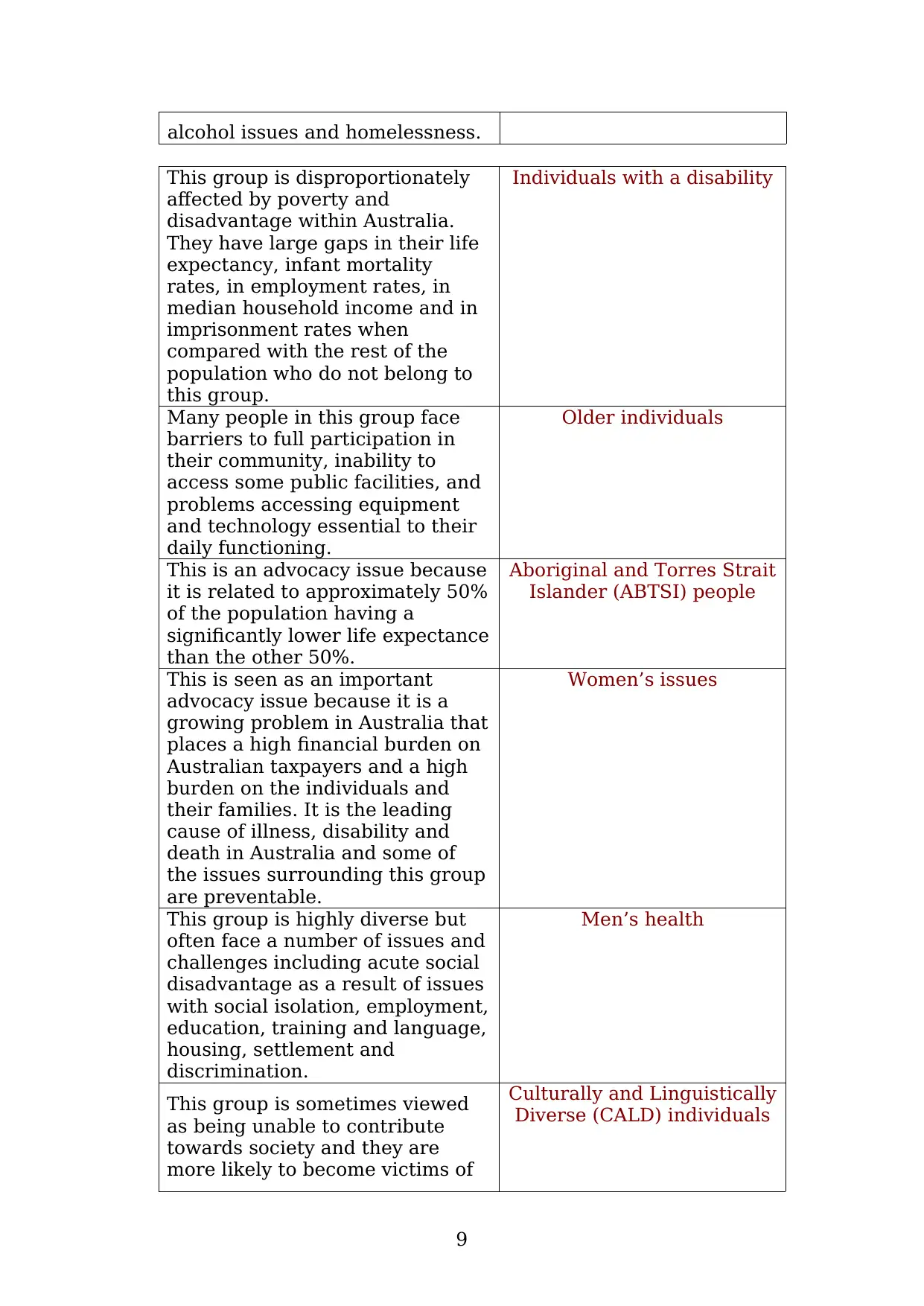
alcohol issues and homelessness.
This group is disproportionately
affected by poverty and
disadvantage within Australia.
They have large gaps in their life
expectancy, infant mortality
rates, in employment rates, in
median household income and in
imprisonment rates when
compared with the rest of the
population who do not belong to
this group.
Individuals with a disability
Many people in this group face
barriers to full participation in
their community, inability to
access some public facilities, and
problems accessing equipment
and technology essential to their
daily functioning.
Older individuals
This is an advocacy issue because
it is related to approximately 50%
of the population having a
significantly lower life expectance
than the other 50%.
Aboriginal and Torres Strait
Islander (ABTSI) people
This is seen as an important
advocacy issue because it is a
growing problem in Australia that
places a high financial burden on
Australian taxpayers and a high
burden on the individuals and
their families. It is the leading
cause of illness, disability and
death in Australia and some of
the issues surrounding this group
are preventable.
Women’s issues
This group is highly diverse but
often face a number of issues and
challenges including acute social
disadvantage as a result of issues
with social isolation, employment,
education, training and language,
housing, settlement and
discrimination.
Men’s health
This group is sometimes viewed
as being unable to contribute
towards society and they are
more likely to become victims of
Culturally and Linguistically
Diverse (CALD) individuals
9
This group is disproportionately
affected by poverty and
disadvantage within Australia.
They have large gaps in their life
expectancy, infant mortality
rates, in employment rates, in
median household income and in
imprisonment rates when
compared with the rest of the
population who do not belong to
this group.
Individuals with a disability
Many people in this group face
barriers to full participation in
their community, inability to
access some public facilities, and
problems accessing equipment
and technology essential to their
daily functioning.
Older individuals
This is an advocacy issue because
it is related to approximately 50%
of the population having a
significantly lower life expectance
than the other 50%.
Aboriginal and Torres Strait
Islander (ABTSI) people
This is seen as an important
advocacy issue because it is a
growing problem in Australia that
places a high financial burden on
Australian taxpayers and a high
burden on the individuals and
their families. It is the leading
cause of illness, disability and
death in Australia and some of
the issues surrounding this group
are preventable.
Women’s issues
This group is highly diverse but
often face a number of issues and
challenges including acute social
disadvantage as a result of issues
with social isolation, employment,
education, training and language,
housing, settlement and
discrimination.
Men’s health
This group is sometimes viewed
as being unable to contribute
towards society and they are
more likely to become victims of
Culturally and Linguistically
Diverse (CALD) individuals
9
⊘ This is a preview!⊘
Do you want full access?
Subscribe today to unlock all pages.

Trusted by 1+ million students worldwide
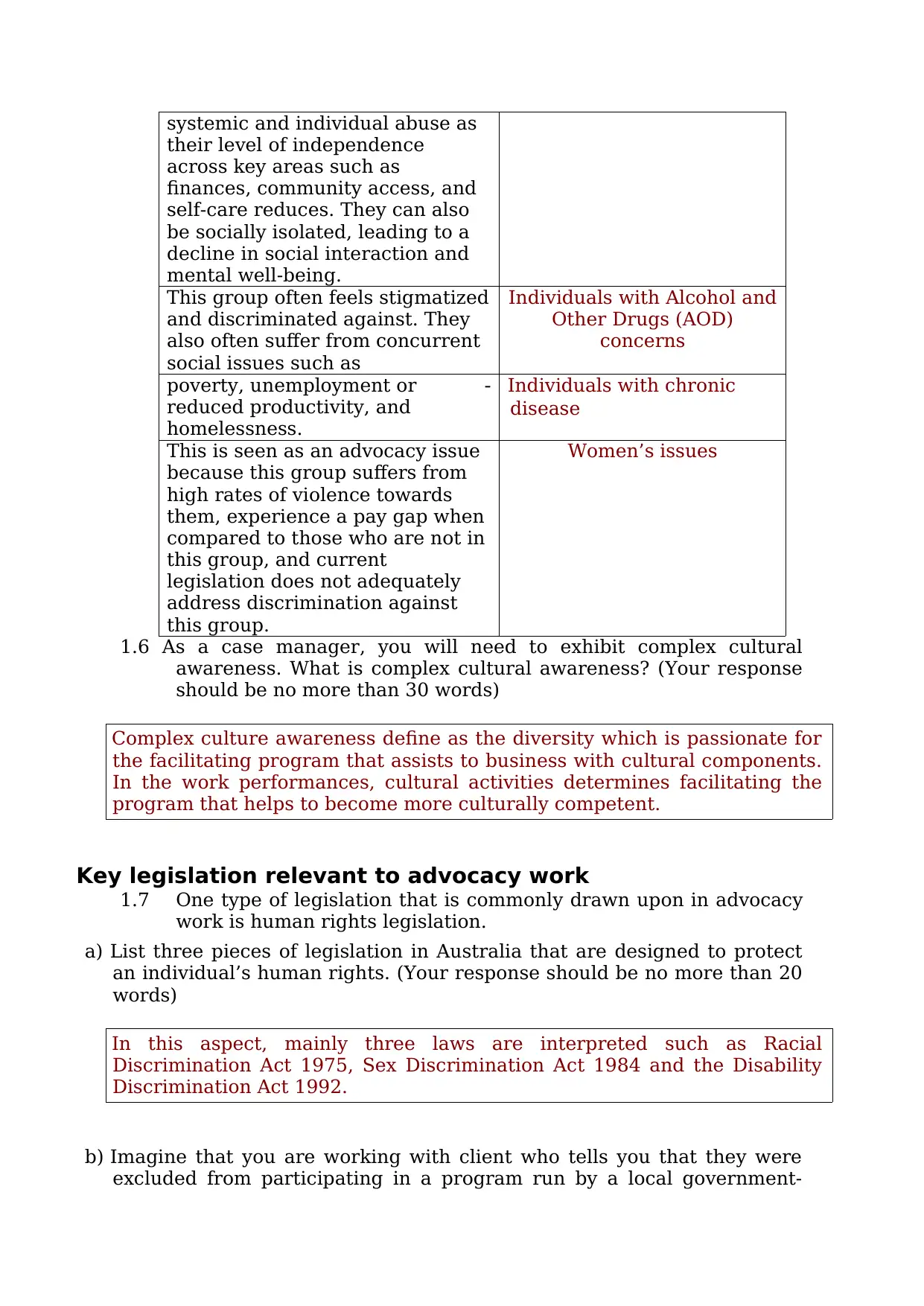
systemic and individual abuse as
their level of independence
across key areas such as
finances, community access, and
self-care reduces. They can also
be socially isolated, leading to a
decline in social interaction and
mental well-being.
This group often feels stigmatized
and discriminated against. They
also often suffer from concurrent
social issues such as
Individuals with Alcohol and
Other Drugs (AOD)
concerns
poverty, unemployment or
reduced productivity, and
homelessness.
- Individuals with chronic
disease
This is seen as an advocacy issue
because this group suffers from
high rates of violence towards
them, experience a pay gap when
compared to those who are not in
this group, and current
legislation does not adequately
address discrimination against
this group.
Women’s issues
1.6 As a case manager, you will need to exhibit complex cultural
awareness. What is complex cultural awareness? (Your response
should be no more than 30 words)
Complex culture awareness define as the diversity which is passionate for
the facilitating program that assists to business with cultural components.
In the work performances, cultural activities determines facilitating the
program that helps to become more culturally competent.
Key legislation relevant to advocacy work
1.7 One type of legislation that is commonly drawn upon in advocacy
work is human rights legislation.
a) List three pieces of legislation in Australia that are designed to protect
an individual’s human rights. (Your response should be no more than 20
words)
In this aspect, mainly three laws are interpreted such as Racial
Discrimination Act 1975, Sex Discrimination Act 1984 and the Disability
Discrimination Act 1992.
b) Imagine that you are working with client who tells you that they were
excluded from participating in a program run by a local government-
their level of independence
across key areas such as
finances, community access, and
self-care reduces. They can also
be socially isolated, leading to a
decline in social interaction and
mental well-being.
This group often feels stigmatized
and discriminated against. They
also often suffer from concurrent
social issues such as
Individuals with Alcohol and
Other Drugs (AOD)
concerns
poverty, unemployment or
reduced productivity, and
homelessness.
- Individuals with chronic
disease
This is seen as an advocacy issue
because this group suffers from
high rates of violence towards
them, experience a pay gap when
compared to those who are not in
this group, and current
legislation does not adequately
address discrimination against
this group.
Women’s issues
1.6 As a case manager, you will need to exhibit complex cultural
awareness. What is complex cultural awareness? (Your response
should be no more than 30 words)
Complex culture awareness define as the diversity which is passionate for
the facilitating program that assists to business with cultural components.
In the work performances, cultural activities determines facilitating the
program that helps to become more culturally competent.
Key legislation relevant to advocacy work
1.7 One type of legislation that is commonly drawn upon in advocacy
work is human rights legislation.
a) List three pieces of legislation in Australia that are designed to protect
an individual’s human rights. (Your response should be no more than 20
words)
In this aspect, mainly three laws are interpreted such as Racial
Discrimination Act 1975, Sex Discrimination Act 1984 and the Disability
Discrimination Act 1992.
b) Imagine that you are working with client who tells you that they were
excluded from participating in a program run by a local government-
Paraphrase This Document
Need a fresh take? Get an instant paraphrase of this document with our AI Paraphraser
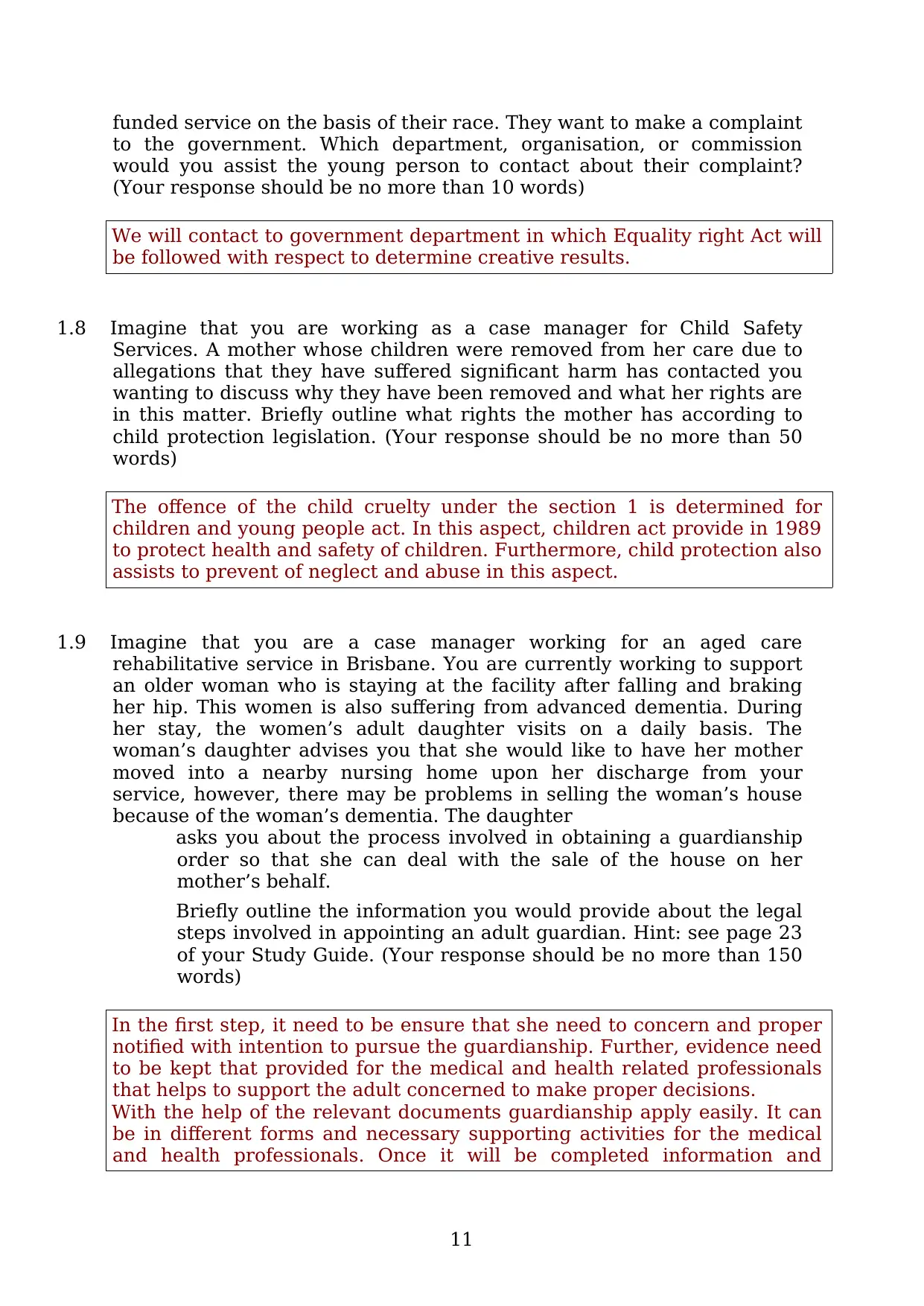
funded service on the basis of their race. They want to make a complaint
to the government. Which department, organisation, or commission
would you assist the young person to contact about their complaint?
(Your response should be no more than 10 words)
We will contact to government department in which Equality right Act will
be followed with respect to determine creative results.
1.8 Imagine that you are working as a case manager for Child Safety
Services. A mother whose children were removed from her care due to
allegations that they have suffered significant harm has contacted you
wanting to discuss why they have been removed and what her rights are
in this matter. Briefly outline what rights the mother has according to
child protection legislation. (Your response should be no more than 50
words)
The offence of the child cruelty under the section 1 is determined for
children and young people act. In this aspect, children act provide in 1989
to protect health and safety of children. Furthermore, child protection also
assists to prevent of neglect and abuse in this aspect.
1.9 Imagine that you are a case manager working for an aged care
rehabilitative service in Brisbane. You are currently working to support
an older woman who is staying at the facility after falling and braking
her hip. This women is also suffering from advanced dementia. During
her stay, the women’s adult daughter visits on a daily basis. The
woman’s daughter advises you that she would like to have her mother
moved into a nearby nursing home upon her discharge from your
service, however, there may be problems in selling the woman’s house
because of the woman’s dementia. The daughter
asks you about the process involved in obtaining a guardianship
order so that she can deal with the sale of the house on her
mother’s behalf.
Briefly outline the information you would provide about the legal
steps involved in appointing an adult guardian. Hint: see page 23
of your Study Guide. (Your response should be no more than 150
words)
In the first step, it need to be ensure that she need to concern and proper
notified with intention to pursue the guardianship. Further, evidence need
to be kept that provided for the medical and health related professionals
that helps to support the adult concerned to make proper decisions.
With the help of the relevant documents guardianship apply easily. It can
be in different forms and necessary supporting activities for the medical
and health professionals. Once it will be completed information and
11
to the government. Which department, organisation, or commission
would you assist the young person to contact about their complaint?
(Your response should be no more than 10 words)
We will contact to government department in which Equality right Act will
be followed with respect to determine creative results.
1.8 Imagine that you are working as a case manager for Child Safety
Services. A mother whose children were removed from her care due to
allegations that they have suffered significant harm has contacted you
wanting to discuss why they have been removed and what her rights are
in this matter. Briefly outline what rights the mother has according to
child protection legislation. (Your response should be no more than 50
words)
The offence of the child cruelty under the section 1 is determined for
children and young people act. In this aspect, children act provide in 1989
to protect health and safety of children. Furthermore, child protection also
assists to prevent of neglect and abuse in this aspect.
1.9 Imagine that you are a case manager working for an aged care
rehabilitative service in Brisbane. You are currently working to support
an older woman who is staying at the facility after falling and braking
her hip. This women is also suffering from advanced dementia. During
her stay, the women’s adult daughter visits on a daily basis. The
woman’s daughter advises you that she would like to have her mother
moved into a nearby nursing home upon her discharge from your
service, however, there may be problems in selling the woman’s house
because of the woman’s dementia. The daughter
asks you about the process involved in obtaining a guardianship
order so that she can deal with the sale of the house on her
mother’s behalf.
Briefly outline the information you would provide about the legal
steps involved in appointing an adult guardian. Hint: see page 23
of your Study Guide. (Your response should be no more than 150
words)
In the first step, it need to be ensure that she need to concern and proper
notified with intention to pursue the guardianship. Further, evidence need
to be kept that provided for the medical and health related professionals
that helps to support the adult concerned to make proper decisions.
With the help of the relevant documents guardianship apply easily. It can
be in different forms and necessary supporting activities for the medical
and health professionals. Once it will be completed information and
11

contact information will be review. In addition to this, there are proper
hearing require which is expected for the applicant and attend to make
proper arrangement for the concerned party. Public guardian also require
on the behalf of adult need.
hearing require which is expected for the applicant and attend to make
proper arrangement for the concerned party. Public guardian also require
on the behalf of adult need.
⊘ This is a preview!⊘
Do you want full access?
Subscribe today to unlock all pages.

Trusted by 1+ million students worldwide
1 out of 34
Related Documents
Your All-in-One AI-Powered Toolkit for Academic Success.
+13062052269
info@desklib.com
Available 24*7 on WhatsApp / Email
![[object Object]](/_next/static/media/star-bottom.7253800d.svg)
Unlock your academic potential
Copyright © 2020–2025 A2Z Services. All Rights Reserved. Developed and managed by ZUCOL.





